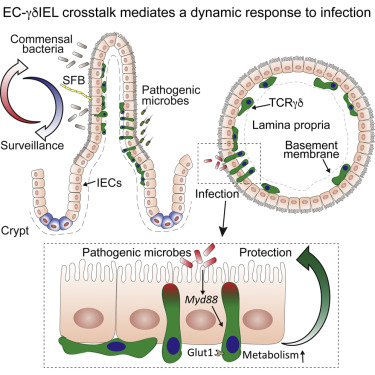Our official English website, www.x-mol.net, welcomes your feedback! (Note: you will need to create a separate account there.)
Intestinal Epithelial and Intraepithelial T Cell Crosstalk Mediates a Dynamic Response to Infection.
Cell ( IF 64.5 ) Pub Date : 2017-Nov-02 , DOI: 10.1016/j.cell.2017.08.046 David P. Hoytema van Konijnenburg , Bernardo S. Reis , Virginia A. Pedicord , Julia Farache , Gabriel D. Victora , Daniel Mucida
Cell ( IF 64.5 ) Pub Date : 2017-Nov-02 , DOI: 10.1016/j.cell.2017.08.046 David P. Hoytema van Konijnenburg , Bernardo S. Reis , Virginia A. Pedicord , Julia Farache , Gabriel D. Victora , Daniel Mucida

|
Intestinal intraepithelial lymphocytes (IELs) are located at the critical interface between the intestinal lumen, which is chronically exposed to food and microbes, and the core of the body. Using high-resolution microscopy techniques and intersectional genetic tools, we investigated the nature of IEL responses to luminal microbes. We observed that TCRγδ IELs exhibit unique microbiota-dependent location and movement patterns in the epithelial compartment. This behavioral pattern quickly changes upon exposure to different enteric pathogens, resulting in increased interepithelial cell (EC) scanning, expression of antimicrobial genes, and glycolysis. Both dynamic and metabolic changes to γδ IEL depend on pathogen sensing by ECs. Direct modulation of glycolysis is sufficient to change γδ IEL behavior and susceptibility to early pathogen invasion. Our results uncover a coordinated EC-IEL response to enteric infections that modulates lymphocyte energy utilization and dynamics and supports maintenance of the intestinal epithelial barrier. VIDEO ABSTRACT.
中文翻译:

肠上皮和上皮内T细胞串扰介导对感染的动态反应。
肠上皮内淋巴细胞(IEL)位于肠腔之间的关键界面,肠腔长期暴露于食物和微生物,与人体核心之间。使用高分辨率的显微镜技术和交叉遗传工具,我们调查了IEL对腔微生物的反应的性质。我们观察到,TCRγδIELs在上皮区室中表现出独特的微生物群依赖性位置和运动模式。暴露于不同的肠道病原体后,这种行为模式迅速改变,从而导致上皮间细胞(EC)扫描,抗菌素基因的表达和糖酵解增加。γδIEL的动态变化和代谢变化均取决于EC对病原体的感知。糖酵解的直接调节足以改变γδIEL行为和对早期病原体入侵的敏感性。我们的研究结果揭示了对肠感染的协调一致的EC-IEL反应,该反应调节淋巴细胞的能量利用和动力学,并支持维持肠上皮屏障。视频摘要。
更新日期:2017-09-21
中文翻译:

肠上皮和上皮内T细胞串扰介导对感染的动态反应。
肠上皮内淋巴细胞(IEL)位于肠腔之间的关键界面,肠腔长期暴露于食物和微生物,与人体核心之间。使用高分辨率的显微镜技术和交叉遗传工具,我们调查了IEL对腔微生物的反应的性质。我们观察到,TCRγδIELs在上皮区室中表现出独特的微生物群依赖性位置和运动模式。暴露于不同的肠道病原体后,这种行为模式迅速改变,从而导致上皮间细胞(EC)扫描,抗菌素基因的表达和糖酵解增加。γδIEL的动态变化和代谢变化均取决于EC对病原体的感知。糖酵解的直接调节足以改变γδIEL行为和对早期病原体入侵的敏感性。我们的研究结果揭示了对肠感染的协调一致的EC-IEL反应,该反应调节淋巴细胞的能量利用和动力学,并支持维持肠上皮屏障。视频摘要。



























 京公网安备 11010802027423号
京公网安备 11010802027423号